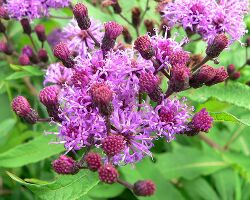Biology:Vernonieae
From HandWiki
(Redirected from Biology:Iodocephalopsis)
Short description: Tribe of flowering plants
| Vernonieae | |
|---|---|

| |
| Vernonia altissima | |
| Scientific classification | |
| Kingdom: | Plantae |
| Clade: | Tracheophytes |
| Clade: | Angiosperms |
| Clade: | Eudicots |
| Clade: | Asterids |
| Order: | Asterales |
| Family: | Asteraceae |
| Subfamily: | Vernonioideae |
| Tribe: | Vernonieae Cassini |
| Subtribes | |
| |
Vernonieae is a tribe of about 1300 species of plants in the aster family. They are mostly found in the tropics and warmer temperate areas, both in the Americas and the Old World. They are mostly herbaceous plants or shrubs, although there is at least one tree species, Vernonia arborea.[1]
Taxonomy
Vernonieae is considered sister to the tribe Liabeae.[1][2][3] The tribe originated in southern Africa or Madagascar , and spread to the Americas in at least two different events.[2]
In many works some 80% of the species in this tribe are classified in the genus Vernonia. Other authors, like Harold E. Robinson, divide the tribe into a larger number of small genera.[1]
References
- ↑ 1.0 1.1 1.2 "187d. Asteraceae Martinov tribe Vernonieae Cassini". Flora of North America. http://www.efloras.org/florataxon.aspx?flora_id=1&taxon_id=20545.
- ↑ 2.0 2.1 Keeleya, S. C. (2007). "A phylogeny of the "evil tribe" (Vernonieae: Compositae) reveals Old/New World long distance dispersal: support from separate and combined congruent datasets (trnL-F, ndhF, ITS)". Molecular Phylogenetics and Evolution 44 (1): 89–103. doi:10.1016/j.ympev.2006.12.024. PMID 17292633.
- ↑ Panero, J. L.; V. A. Funk (2002-12-30). "Toward a phylogenetic subfamilial classification for the Compositae (Asteraceae)". Proceedings of the Biological Society of Washington (Biological Society of Washington) 115 (4): 909–922. https://www.biodiversitylibrary.org/page/35519280#page/927/mode/1up.
External links
- Cassini, Alexandre de (1794–1823). "unknown". Journal de Physique, de Chimie et d'Histoire Naturelle (Paris) 88: 196. J. Phys. Chim. Hist. Nat. Arts. https://archive.org/details/journaldephysiqu88pari. Retrieved 2008-06-30.
Wikidata ☰ Q146630 entry
 |

